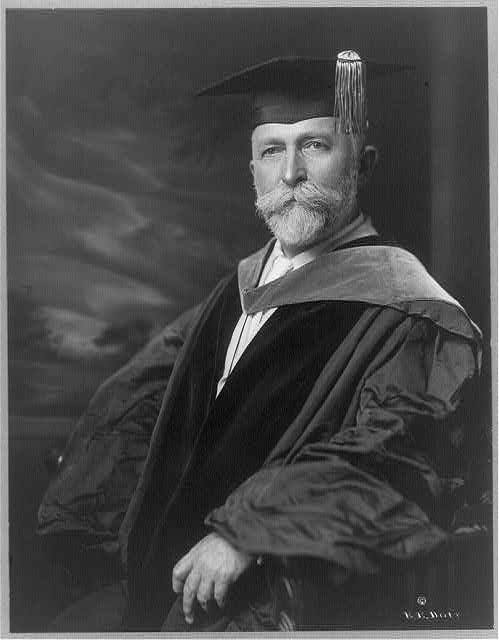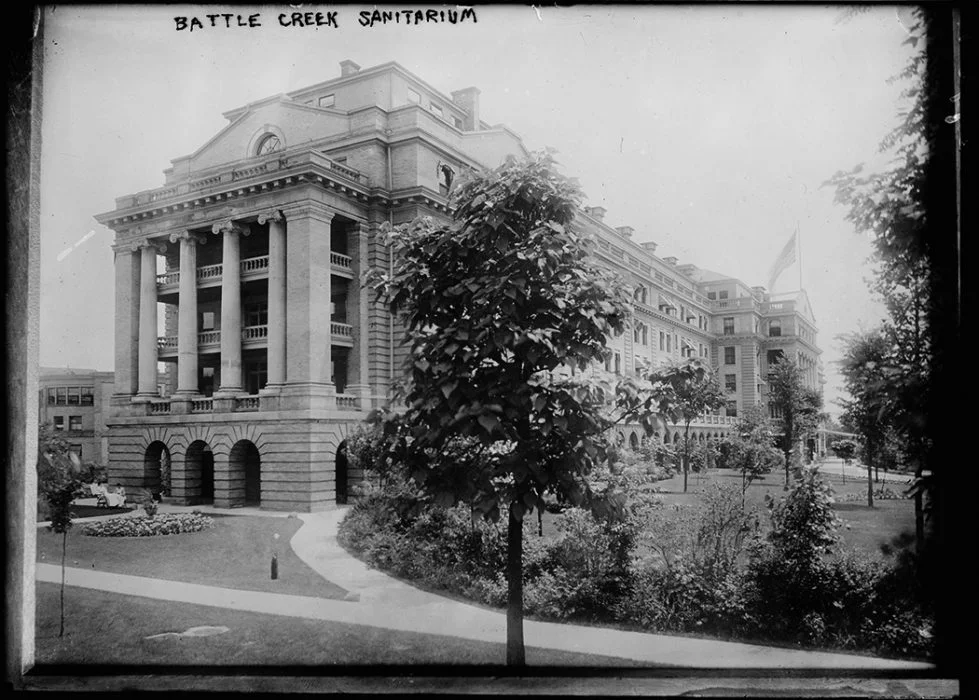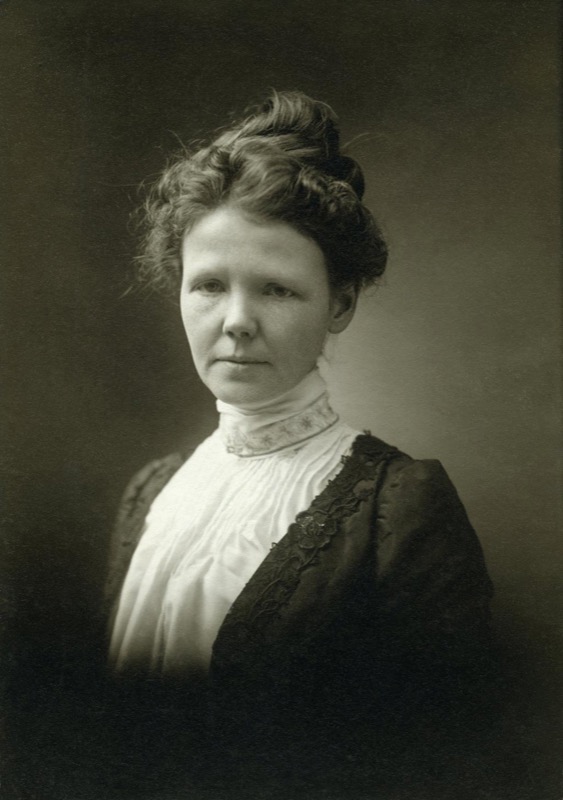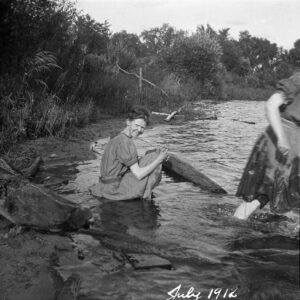The following letter was written by St. Croix Falls resident, Mary Lovila Baker, to her husband, Major J.S. Baker, during her stay at the state-of-the-art Battle Creek Sanitarium. Major Baker was sent to St. Croix Falls in 1874 to manage the land holdings of U.S. Attorney General Caleb Cushing. Cushing was granted 36,000 acres and natural resources in the St. Croix River Valley by the United States Government under the 1862 Morrill Act and started the Cushing Land Agency. This Act alone expropriated over ten million acres of Indigenous land throughout the U.S. The intention of this land grant act was to provide opportunities to thousands of farmers and working people previously excluded from public education with the profits from the land sales. Opportunists often misused or loosely interpreted the terms of this system, and oftentimes, these land grants never benefited the establishment of public schools. Major J.S. Baker later bought Cushing Land Agency and continued to run the business as Baker Land and Title Company, located at 106 S. Washington Street. Mary Lovila Baker was the second wife of Major J.S. Baker and the mother of his four youngest children.
My Dear Major,
Am well settled in a comfortable and pleasant room after an easy journey. Soon after my arrival a nurse came to my room and requested me to call on Dr. Mosher at 4 o’clock (Dr. Mosher is a woman) for a physical examination. They require this if one takes the baths and rubbing and one of the nurses piloted me into the basement where there were long rows of little rooms for dressing. I entered one and disrobed putting on a sheet and blanket: then into bathrooms, then into a room where I laid on a cot on my stomach and hot applications were placed on my back then into a warm bath, then rubbed and spotting all over. I felt good after that for a while, then I was wrapped in a sheet and taken to the Doctor’s office where she put me through a rigid examination. Sounded my lungs, rolled and pinched my stomach. She says my stomach is badly dilated and out of place. The muscles of the abdomen are weak and need strengthening. I must have manual Swedish movement every day, electric, and massage treatments. These are all extras and an extra charge is made for these treatments. Sunday there is to be a gastric test and my blood will be examined. Then I suppose she can tell my whole condition. I knew my stomach was not normal but I did not know the difficulty. The doctor makes out my bill of fare for every meal. She wants to try and get some flesh on me – says I am not properly nourished. Of course, the diet is very simple and no drink at meals for me. The mechanical Swedish movements are very queer. I was not strong enough to take but a few this morning. It exercises all your muscles. I laid on my back and it felt like something was kneading me all up and down my back. I was quite surprised when the doctor told me I was torn. Tho’ I’ve had bad feelings there occasionally, I laid it to the change of life. It must have been when Florence was born for Dr. Arnold said I was not torn at Winnie’s birth. You know I was sick only a short time with Florence and she was large. Doctors ought to be more careful. If he had told me at the time it could have been fixed all right. Very few women but are torn and it is cause of much poor health. Saturday is kept as their Sabbath. No treatments are given on that day. Doctor Kellogg is still performing operations. He sometimes performs between 30 and 40 a day. I should think he’d be too old. One lady said he’d spent so much time learning how to cook, she didn’t see how he could know much about surgery. My expenses will be so high I won’t care to stay very long tho’ the doctor said I had neglected myself too long. I will know sometime Sunday what she thinks and will let you know. My room is a front one, very pleasant on third floor $28 a week. It is a very lovely place with every appliance for ones comfort so I suppose that is the cause of the great expense. I must close now and rest. I feel as tho’ I’d been put thru’ a good deal this pre-noon.
With much love, Mary

Portrait of Dr. John Harvey Kellogg courtesy of the Library of Congress.
Mary Lovila Baker (1860-1913), a resident of St. Croix Falls and wife of Major J.S. Baker, wrote this letter during a three-week stay at the nationally famous Battle Creek Sanitarium in Battle Creek, Michigan. The Sanitarium is best remembered for its notorious Director and head surgeon, Dr. John Harvey Kellogg.
A man obsessed with bodily cleanliness, Dr. Kellogg coined the term “sanitarium.” He was the inventor of a philosophical wellness movement called “biological living,” which combined science and principles from his Seventh-Day Adventist beliefs. The doctor was typically dressed in an all-white suit and a white cockatoo perched on his shoulder. He believed meat, salt, sugars, and fats were to blame for American society’s physical and moral decline. For Kellogg, breakfast cereal was the remedy to keep Americans from mortal sin. He is best known as the inventor of cornflakes, which he created as a part of his diet regimen for patients.
Dr. Kellogg was also a prominent leader of the eugenics movement and believed it was yet another way to save American society from itself. In January of 1913, he organized the First National Conference on Race Betterment held at the sanitarium. During this conference, “experts” held “mental and physical perfection” pageants where children were tested and evaluated. The winners received medals. As a part of this movement, Kellogg was also a strong supporter of forced sterilizations. Because of his influence, the local college in Battle Creek defined “race betterment” through eugenics as its primary focus and there was an expectation that all students and staff support the theory.
Dr. Kellogg became the Director of The Battle Creek Sanitarium in 1876 and quickly implemented cutting-edge wellness treatments. The sanitarium itself was part health spa, hospital, and luxury hotel. A stay there meant a rigid schedule of treatments, a personalized vegetarian diet, and abstaining from smoking, alcohol, and sex. The treatments are what we would consider today as experimental and highly unusual. Dr. Kellogg used hydrotherapy, phototherapy, electrotherapy, open-air and cold-air therapy, enemas, physical exercise, a patented slapping machine, and surgeries performed by Kellogg himself. Dr. Kellogg’s way of living was applauded by affluent Americans, and his sanitarium was visited by those of the upper echelon like Mary Todd Lincoln, Thomas Edison, Henry Ford, and C.W. Post, the inventor of Grape Nuts.

The Battle Creek Sanitarium in Battle Creek, Michigan.
In the remainder of Mary Baker’s letters, she writes about how she regularly attended Dr. Kellogg’s evening lectures and was” learning lots of things here that will help me take care of my family. I want them to be healthy and firmly believe in Doctor Kellogg’s methods.” Many of her treatments involved being wrapped up like a “mummy” and being made to sit outside in the January air for two or three hours a day. Mary wrote to Major J.S. Baker about the wonderful breakfast foods served there and hoped to have some cereal shipped back home to St. Croix Falls. However, her stay at the Sanitarium ended somewhat abruptly when she feared Dr. Kellogg was going to operate on her without her husband’s consent. By January 26th, Mary packed her trunk and took the train to Lansing against her doctor’s wishes.
Winifred Herberg, a descendant of the Baker family, transcribed letters from Mary. Herberg did not edit or correct mechanics, so the letter is exactly as it was written in 1909 when Mary was writing home to St. Croix Falls.



Recent Comments